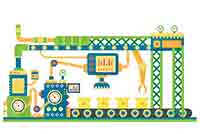-
Sequencing moves to the twenty-first century
Since its development in the late 1970s, DNA sequencing has become one of the most influential tools in biomedical research, with technologies evolving continuously and new applications emerging over time. Read more.
Audio
The origins and impact of DNA sequencing
To commemorate the 40th anniversary of Sanger sequencing, in 2017 Anand Jagatia spoke with National Human Genome Research Institute Director Eric Green on the impact and potential of DNA sequencing in biomedical research. Listen to the interview.
-
2000
Drosophila melanogaster genome
-
2000
Arabidopsis thaliana genome
-
Milestone 1 2001
The Human Genome Project
Video
How a worm showed us the way to open science
Watch Robert H. Waterston, Professor of Genome Sciences at the University of Washington and one of the pioneers of the Human Genome Project, recall the promise, pitfalls and potential of this landmark international effort.
Please visit YouTube to view this video.
-
2002
Mus musculus genome
-
2002
Browsing the genome
-
Milestone 2 2004
Sequencing the unculturable majority
-
2005
HapMap
-
2005
Pan troglodytes genome
-
2005
Oryza sativa genome
-
Milestone 3 2005
Sequencing — the next generation
-
Milestone 4 2007
ChIP–seq captures the chromatin landscape
-
2008
Chromatin comes into the open with DNase-seq
-
Milestone 5 2008
The dawn of personal genomes
-
Milestone 6 2008
A sequencing revolution in cancer
-
2008
Genomes Assemble!
-
Milestone 7 2008
Transcriptomes – a new layer of complexity
-
2008
Prenatal genomic medicine
-
2009
An explosion of computational tools
-
Milestone 8 2009
Long reads become a reality
-
Milestone 9 2009
Exploring whole exomes
-
2009
Mapping the methylome
-
2009
Found in translation
-
Milestone 10 2009
Probing nuclear architecture with Hi-C
-
Milestone 11 2009
Sequencing one cell at a time
-
2010
From short reads to giant (panda) genome
-
2010
Expanding sequencing platforms
-
Milestone 12 2010
Waking the dead: sequencing archaic hominin genomes
Video
How ancient DNA sequencing changed the game
Watch Beth Shapiro, Professor of Ecology and Evolutionary Biology at the University of California, Santa Cruz (UCSC), Associate Director of the UCSC Genomics Institute and Investigator at the Howard Hughes Medical Center, discuss the impact of genomic sequencing on the field of ancient DNA research.
Please visit YouTube to view this video.
-
Milestone 13 2012
Cataloguing a public genome
-
Milestone 14 2012
Our most elemental encyclopaedia
Video
The Story of You: ENCODE and the human genome
Ever since a monk called Mendel started breeding pea plants we have been learning about our genomes. The Human Genome Project identified the entire 3-billion letter code contained in the average human genome. Since 2003, the ENCODE project has been trying to interpret that code, to work out how it is used to make different types of cells and different people — the latest chapter in the story of you.
Please visit YouTube to view this video.
-
2013
Danio rerio genome
-
2013
Tackling the epigenome
-
Milestone 15 2014
Pan-genomes: moving beyond the reference
-
Video 2015
Epigenome: The symphony in your cells
Why does a heart cell differ from a brain cell when almost every cell in your body has the same genome? The regulation of gene expression establishes a layer of chemical signatures, the epigenome, that ensures cells use their genomes in different ways depending on their roles, similar to how orchestras can perform one piece of music in various ways. In 2015, the NIH Roadmap Epigenomics Consortium reported the integrative analysis of 111 reference human epigenomes, including profiles of histone modification patterns, DNA accessibility, DNA methylation and RNA expression, to systematically characterize epigenomic landscapes in primary human tissues and cells. This work demonstrated how a cell’s epigenome is complex and exquisitely arranged — just like a Beethoven symphony.
Please visit YouTube to view this video.
-
2016
Short reads go long range
-
Milestone 16 2017
Genomes go platinum
-
Milestone 17 2020
Filling in the gaps telomere to telomere
Milestones in Genomic Sequencing
 Download all of the articles in one PDF
Download all of the articles in one PDF


































